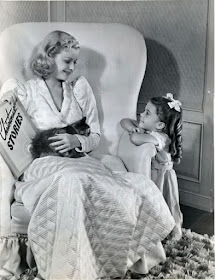Circa
March and April 1935, Metro-Goldwyn-Mayer theatrically released an eight-minute
cartoon titled The Calico Dragon, as part of their series of animated
cartoons known as the Happy Harmonies. With Walt Disney offering a series of
musical animated cartoon shorts, Silly Symphonies, and with Warner Brothers
producing Merrie Melodies, MGM’s first foray into the animation business was
Happy Harmonies – each containing a whimsical song.
 |
| The Calico Dragon (1935) |
In The
Calico Dragon, a little girl falls
asleep after reading a fairy tale to her doll, and quickly observes many of her
toys coming to life in a land of make believe. The toys act out a fairy tale in
which a prince fights a three-headed calico dragon. The cartoon would later be
nominated for an Academy Award for Best Short Subject (Cartoon).
So what does this 1935 animated cartoon have to do with The
Cinnamon Bear? Well, it turns out this cartoon may have been the germ of an
idea for the radio program. At least, that is the theory going around these
days.
I would like to point out that The Calico Dragon being
the inspiration for The Cinnamon Bear is a merely a “theory” and not a
fact.
 |
| The Calico Dragon (1935) |
The
Cinnamon Bear premiered
on radio 80 years ago in November 1937 as a syndicated feature of Transco
(Transcription Company of America). The series creators, Glanville and
Elizabeth Heisch, were still around throughout the 1980s and their memories of
how they created The Cinnamon Bear never included reference to any
theatrical cartoon. But if the Heischs
saw The Calico Dragon in the spring of 1935, it remains probable that
the idea of a Crazy Quilt Dragon and two children falling asleep and traveling
to a fairytale land, originated with this cartoon.

The
timing may be right if one wanted to apply reverse hindsight. In order for the
radio serial to premiere in November 1937, the 16-inch transcription discs (and
12-inch promotional disc) needed to be advertised in trade columns by September
or October. This meant all 26 episodes needed to be recorded in the studio no
later than summer of 1937. The radio scripts and music (co-written by Glanville
Heisch and Don Honrath) were no doubt written in the winter and spring of 1937.
This buys them the entire calendar month of 1936 to plot the series before
scripting. No serial of this caliber could possibly be created and produced
within a few short weeks. The timing is about right.
In
1941, Transco went out of business and sold all interest in their programming to
the Broadcasters Program Syndicate. As a result, The Cinnamon Bear was
supposedly not broadcast over the airwaves in 1941-42. This was only
temporarily and the program soon returned to the air under new ownership. In
the 1950s, syndication was taken over by Lou R. Winston, also based in
Hollywood.
 |
| The Unaired TV Pilot |
In
1951, a television pilot was produced using hand puppets and the audio from the
radio broadcasts. The program never made a successful transition to a visual
medium, remaining solely as a radio property. For decades The Cinnamon Bear
has become an advent calendar for many families who made it an annual tradition
to listen to the episodes daily from Thanksgiving to Christmas. In the 1970s,
Lipman’s in Portland, Oregon, sponsored the radio program over local radio
stations and for a few years had an employee dressed up in a brown bear
costume, playing the role for a new generation growing up with the timeless
serial.
Listening
to the program today, however, you can understand how radio listeners in the
1930s and 1940s envisioned an animated cartoon. Musical instruments supply
simulated sound effects, and a musical song is featured in most of the
chapters.
Fans
of The Cinnamon Bear may be interested in knowing that every year on
selected days in November and December, in Potland, Oregon, the Portland Spirit
is transformed into a Cinnamon Bear Cruise, complete with Queen Melissa, The
Cinnamon Bear, Captain Taffy and The Crazy Quilt Dragon (all pictured above).
For a one-time fee, children can ride the cruise, have their photo taken with
The Cinnamon Bear, and a light snack buffet. For more information you can visit
the website listed below. Incidentally, obsessed fans of The Cinnamon Bear
may want to take advantage of their incredibly low price of $10 for a stuffed
Cinnamon Bear or Crazy Quilt Dragon, available for sale in the gift shop on the
website.























